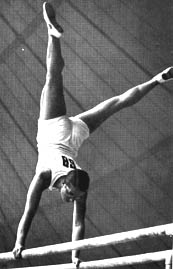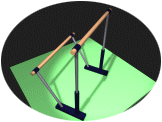|
|
A sight backwards
...
Already in 1830 the Frenchman Amoros wrote of uneven
and asymmetrically adjusted bars in a very successful textbook (“Manuel
d’education physique et morale”),
which was still published
in 1859 in its ninth edition. This modification of the bars
was not really established in the following time, not at all
as a specific feminine apparatus, since the equal participation
of women was not possible for a long time due to social circumstances.
There were women doing gymnastics around the turn of the century
in the German Gymnastics League, but the real upturn started
after World War II only.
Women
gymnastics, 1861 >>>
|

|
|
Before that, women’s
gymnastics was strongly reminding of men’s gymnastics. As
for them, the twelve events were considered to be the “crown of men’s
gymnastics”, while there were nine events for the women, which consisted
of a mixed competition of athletics and apparatus exercises: horizontal
bar, parallel bars, horse, compulsory without apparatus and exercise
with clubs as well as hundred-meter sprint and ball throw. Later on,
seven events emerged for the women emerged from that in Germany around
1927, which contained a compulsory at bars as well, but at still at
parallel bars.
The asymmetrical
adjusting of the bars was introduced at the first World Championships
for women in 1934 in Budapest.....
|

Uneven bars on public
relation photo 1936
|
|
... its Olympic debut
as a feminine apparatus took place in 1936 in Berlin, even
if there were still two apparatuses available: the men’s bars
for the compulsory and the “other” one as a choice for the
voluntary exercise. Out of the leading nations at that time,
it was only Czechoslovakia who chose the uneven bars. It was
here where the tendency to “double horizontal bar”-gymnastics
was realized for the first time, since these exercises were
not exclusively similar to men’s gymnastics at bars.
Käthe
Sohnemann from the golden German team - but on parallel
bars >>>
|

|
|
After World War
II, at the World Championships in 1950 in Basel, the uneven
bars were still not fully accepted, since the women could (for the last
time) choose between the uneven bars and the swinging rings. The Austrian
Kolar and the Swedish Petterson were the first World Champions to be
entered in the history book of gymnastics.

Special Olympic preparation
in Great Britain 1952:
Synchron, just for fun |
|
The
Olympic Games in Helsinki
two years later pushed the development of the apparatus
forward, since it was a full apparatus there. The first Olympic
Champion at uneven bars was the Hungarian Korondi.
At the World competitions in 1954 the still non-stayed
uneven bars were placed as full and lone apparatus; the growing
dynamics of modern gymnastics led to 39 (!) bar-breaks then! |
|

Marjorie Carter (GBR)
at the Olympic Games in Helsinki 1952 |
|
In
Western Germany the public interest decreased, not
only concerning the uneven bars but generally the international
development of women’s gymnastics. Inconsistent with that were
the innovations of German apparatus-developers such as Richard
Reuther and Rudolf Spieth, who created useful constructions
of stayed double horizontal bars already at the beginning of
the 1950ies (German Gymnastics Celebrations, 1953). But it was
only in 1965 when perfectly stayed double horizontal bars with
struts at all the four posts were erected at the Palatinate
Gymnastics Celebrations.
|
The first world
performance took place at the V. Gymnaestrada in Vienna,
which caused enthusiasm on the side of the gymnasts. The
Technical committee of the World Gymnastics Federation released the
apparatus short time later for the Universiade in Budapest.
Even if the uneven bars had initiated a new era in the training practice
and were applied for a patent in 1966, they were not employed at the
World Championships in Dortmund.
When the exercise of the German-American Doris Fuchs-Brause met
the revolutionary opportunities of the new apparatus with nonstop swinging,
flying and bar-changing there was whistling and booing in the audience
for minutes-with their scores the judges had not fully appreciated this
“new” and dynamic way of gymnastics…
One year later, however, at the European Championships
in the Dutch capital Amsterdam, the new double horizontal
bars of women’s gymnastics could be employed for the first time. Vera
Caslavska (CSR) became European Champion; in Ljubljana in 1970,
the German (GDR) Karin Janz became the first World Champion at
this modern apparatus, which was in constant technical development in
the following years.
|

Karin JANZ, Olympic Champion 1972 in Munich and inventor of
"Janz Sault"
|
|

|
|

Maxi GNAUCK - fom 1979 to 1983 the "Queen of Uneven Bars"
<<< The
revolution on Uneven Bars:
Olga Korbut and her flic flac.
|
|
Due to the integration of two fiberglass
cords, patented since the mid-1960ies, no single bar-break occurred
at the Olympic Games in Munich in 1972!
Constant technical
development…
Contributing to that was the Dutch apparatus manufacturer Janssen&Fritsen,
who supplies international gymnastics events since the mid-1960ies,
having had his Olympic apparatus debut in 1968 and having presented
his apparatus creations at World Championships for the first time in
Warna (Bulgaria) in 1974.
.
After
the supply in Lausanne in 1997,  is now the "Official Apparatus Supplier"
of the first World Championships of the new millennium in the
Belgian town Ghent 2001.
is now the "Official Apparatus Supplier"
of the first World Championships of the new millennium in the
Belgian town Ghent 2001.
There will
used the Top competition bars J&F SYSTEM. F.I.G approved.
Secured by means of a dual cable system with patented slide
lock for easy adjustment. Round railswith fibreglass core and
laminated wood. (Photo right >>>)
Three months before this
highlight of the year already, J&F, as a partner of the
Vlaamse Turnliga VTL, supplies the
new gymnastics center right behind the World Championships
gym in Ghent, which is the biggest gymnastics center in the
Benelux states. At the World Championships these highly modern
facilities -evidently with most modern uneven bars as well-
will be used as official warming-up gym before the performances
of the top-gymnasts in the competition arena in the “Topsporthal
Vlanderen”.
|
|

|
|
(Sources:
Geschichte der Turngeräte. J.Göhler; The History of British Gymnastics.
J.Prestidge; Das Turnjahrhundert der Deutschen. A.Götze/E.Herholz; Flickflack
Weltbühne des Turnens. A.Götze/H.-J.Zeume; Gerätturnen einst und jetzt.
W.Pahncke; Janssen&Fritsen.Katalog 2000)
|









